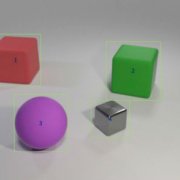Researchers combine statistical and symbolic artificial intelligence techniques to speed learning and improve transparency.
Kim Martineau | MIT Quest for Intelligence
A child who has never seen a pink elephant can still describe one — unlike a computer. “The computer learns from data,” says Jiajun Wu, a PhD student at MIT. “The ability to generalize and recognize something you’ve never seen before — a pink elephant — is very hard for machines.”
Deep learning systems interpret the world by picking out statistical patterns in data. This form of machine learning is now everywhere, automatically tagging friends on Facebook, narrating Alexa’s latest weather forecast, and delivering fun facts via Google search. But statistical learning has its limits. It requires tons of data, has trouble explaining its decisions, and is terrible at applying past knowledge to new situations; It can’t comprehend an elephant that’s pink instead of gray.
To give computers the ability to reason more like us, artificial intelligence (AI) researchers are returning to abstract, or symbolic, programming. Popular in the 1950s and 1960s, symbolic AI wires in the rules and logic that allow machines to make comparisons and interpret how objects and entities relate. Symbolic AI uses less data, records the chain of steps it takes to reach a decision, and when combined with the brute processing power of statistical neural networks, it can even beat humans in a complicated image comprehension test.
A new study by a team of researchers at MIT, MIT-IBM Watson AI Lab, and DeepMind shows the promise of merging statistical and symbolic AI. Led by Wu and Joshua Tenenbaum, a professor in MIT’s Department of Brain and Cognitive Sciences and the Computer Science and Artificial Intelligence Laboratory, the team shows that its hybrid model can learn object-related concepts like color and shape, and leverage that knowledge to interpret complex object relationships in a scene. With minimal training data and no explicit programming, their model could transfer concepts to larger scenes and answer increasingly tricky questions as well as or better than its state-of-the-art peers. The team presents its results at the International Conference on Learning Representations in May...
Read the full article on the MIT News website using the link below.

